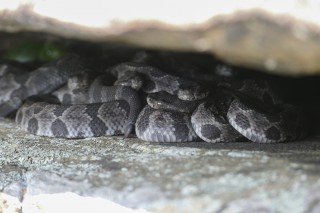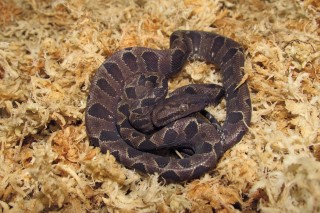
February 21, 2019
Baby Rattlers In The Nursery
- as seen by -
 Michael Lieto
Michael Lieto
The southwestern speckled rattlesnake (Crotalus pyrrhus) is a medium-sized rattlesnake that reaches a maximum length of three feet. This species is found across southern California, southwestern Utah, Arizona, and Baja California. It is associated with arid areas alongside mesas and outcroppings with plenty of rocks and plants such as sagebrush. The snake occurs in a wide variety of colors including cream white, red, tan, pinkish and pale orange. Dark rings around the tail and speckles across the body are the unifying characteristics of this snake (and where it gets its name). Their overall coloration often matches that of the local substrate color. They feed on small rodents and lizards.
This species is a member of the “Speckled Rattlesnake Complex” and was historically considered a subspecies of the speckled rattlesnake (Crotalus mitchellii). However, in 2015, it was determined that its genetic makeup and habitat were unique enough to elevate it to full species status. The southwestern speckled rattlesnake also has smaller fangs than the speckled rattlesnake and a slightly larger head width and rattle segments. All rattlesnakes are venomous though they rarely inflict fatal bites.
Here at WCS’s Bronx Zoo World of Reptiles, we have a trio of cream-colored southwestern speckled rattlesnakes on exhibit consisting of one male and two females. Last year, we noticed one of our females was looking large, and we suspected she was gravid. At the end of July, our suspicions proved correct when we discovered she gave birth to four little snakes overnight (above, adult with a juvenile).
Because these rattlesnakes typically feed on lizards when they are young, they have proven to be difficult feeders at first. With some patience and practice, we were able to get them feeding on pinkie mice, and they are doing well. Though they are only as big as a small plastic cup when curled up, they still possess venom as toxic as their adult counterparts. The small snakes have enough segments to produce short rattles, a sure defensive warning of the venomous nature.
You can see two of these youngsters in the World of Reptiles nursery exhibit.
Nikon D5




Leave a Comment
Edith Luis
February 21, 2019 at 8:42 am
Beautiful! Are they on display yet?
Rachel
February 21, 2019 at 4:34 pm
What gorgeous animals! Keep up the great work!
-Rachel at http://www.wildbioadventures.org
Julie Larsen Maher
February 27, 2019 at 9:28 am
Thanks so much, Edith. You can see the parents and young at the Bronx Zoo’s World of Reptiles. Check the nursery for the babies and the exhibit area for the adults.
Pingback: Discover 15 Astonishing Facts About The Largest Speckled Rattlesnake Ever Found